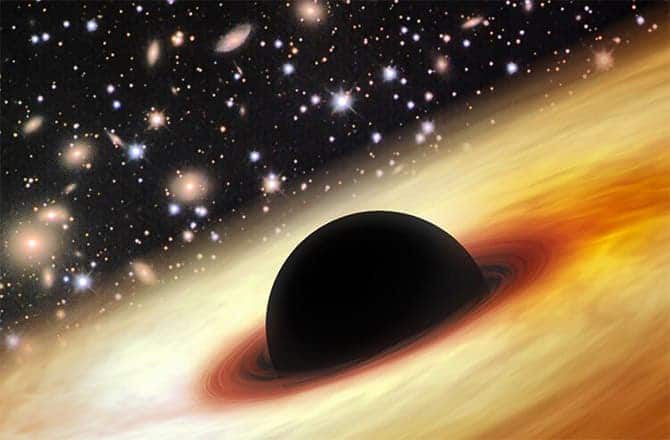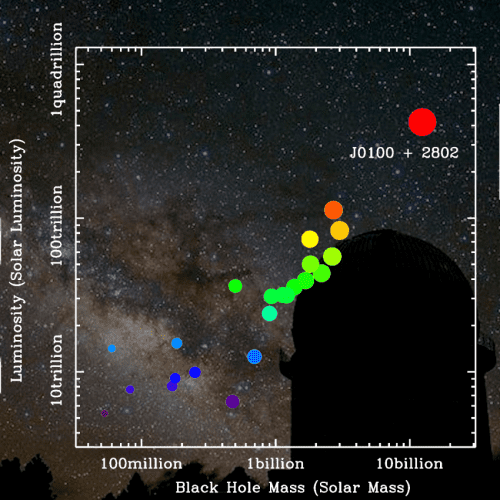Astronomers have discovered a humongous supermassive black hole that’s 12 billion times as massive as the Sun. What’s peculiar about it isn’t necessarily its mass – some even bigger black holes have been found – but rather its age. Observations suggest that the black hole 12.8 billion light-years away, which means what scientists are reading and observing what the black hole looked like 12.8 billion years ago. But that’s only 875 million years after the Big Bang, making it the most massive black hole in the early universe – by far!
A cosmic fat kid

This is an artist’s impression of a quasar with a supermassive black hole in the distant universe. Credit: Zhaoyu Li/NASA/JPL-Caltech/Misti Mountain Observatory
Black holes, of course, can’t be imaged directly since they like to gobble up anything that comes in their line of gravity. Past a certain threshold, called the event horizon, nothing escapes its grasps – not even light. What the astronomers have imaged, however, is the quasar that surrounds the supermassive black hole. Quasars are some of the brightest and most distant objects we can see. These ultra-bright objects are likely the centers of active galaxies where supermassive black holes reside. As material spirals into the black holes, a large part of the mass is converted to energy. It is this energy that we see. And though smaller than our solar system, a single quasar can outshine an entire galaxy of a hundred billion stars. This specific quasar is 40,000 times as luminous as the entire Milky Way.

The newly discovered quasar SDSS J0100+2802 is the one with the most massive black hole and the highest luminosity among all known distant quasars. The background photo, provided by Yunnan Observatory, shows the dome of the 2.4meter telescope and the sky above it. Credit: Zhaoyu Li/Shanghai Observatory
“Before this discovery the most massive black hole known within 1 billion years after the Big Bang was around 5 billion solar mass, less than half the mass of the new detection,” Bram Venemans, research staff scientist with Max Planck Institute for Astronomy in Germany, said for Discovery News.
It’s believed that young block holes from the early universe started off between 100 and 100,000 times the mass of the sun, then grew by steadily eating more matter or by colliding/merging with other black holes. Neither explanations seemingly account for such a massive black hole at its age.
“How can a quasar so luminous, and a black hole so massive, form so early in the history of the universe, at an era soon after the earliest stars and galaxies have just emerged?” said Xiaohui Fan, Regents’ Professor of Astronomy at the UA’s Steward Observatory. “And what is the relationship between this monster black hole and its surrounding environment, including its host galaxy?
“This ultraluminous quasar with its supermassive black hole provides a unique laboratory to the study of the mass assembly and galaxy formation around the most massive black holes in the early universe.”
What the findings reported in Nature seem to suggest is that the co-evolution of galaxies and their central black holes aren’t necessarily linked together. Not in this case at least.









